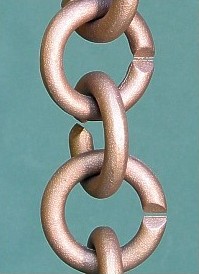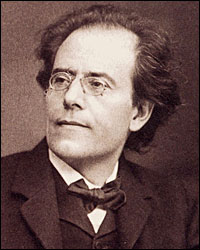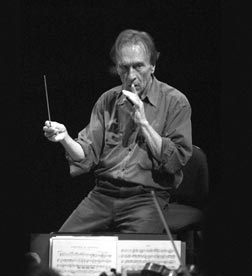Last month | Next monthClassical Month in Washington is a monthly feature. If there are concerts you would like to see included on our schedule, send your suggestions by e-mail (ionarts at gmail dot com). Happy listening!November 1, 2007 (Thu)
7 pmNational Symphony OrchestraWith Iván Fischer and Nikolaj Znaider
Kennedy Center Concert Hall
Review -- Michael Lodico (
Ionarts, November 2)
November 1, 2007 (Thu)
7:30 pmMozart,
Don GiovanniWashington National Opera
Kennedy Center Opera House
Review -- Charles T. Downey (
Ionarts, October 31)
November 1, 2007 (Thu)
7:30 pmHandel,
AlcinaOpera Vivente (Baltimore, Md.)
Review -- Michael Lodico (
Ionarts, October 30)
November 1, 2007 (Thu)
7:30 pmMarian Anderson String QuartetThe Mansion at Strathmore
November 1, 2007 (Thu)
8 pmEvelyn Elsing (cello) and Rita Sloan (piano) [FREE]
Clarice Smith Performing Arts Center
November 2, 2007 (Fri)
8 pmNational Symphony OrchestraWith Iván Fischer and Nikolaj Znaider
Kennedy Center Concert Hall
November 2, 2007 (Fri)
8 pmUniversity of Maryland Symphonic Wind Ensemble [FREE]
Clarice Smith Performing Arts Center
November 2, 2007 (Fri)
8 pmAmerican Chamber PlayersCorcoran Gallery of Art
November 3, 2007 (Sat)
11 amBaltimore Symphony Orchestra (Casual Concert)
Beethoven, 8th symphony (Carolyn Kuan, conductor)
Meyerhoff Symphony Hall (Baltimore, Md.)
November 3, 2007 (Sat)
3 pmMeasha Brueggergosman (soprano) and Roger Vignoles (piano) [FREE, tickets required]
Baltimore Museum of Art
Review -- Tim Smith (
Critical Mass, November 6)
November 3, 2007 (Sat)
7 pmWilliam Bolcom,
A View from the BridgeWashington National Opera
Kennedy Center Opera House
Review -- Michael Lodico (
Ionarts, November 8)
November 3, 2007 (Sat)
7 pmThe Five BrownsMusic Center at Strathmore
November 3, 2007 (Sat)
7:30 pmHandel,
AlcinaOpera Vivente (Baltimore, Md.)
November 3, 2007 (Sat)
7:30 pmPurcell,
Dido and AeneasPeabody Chamber Opera
Grace and Saint Peter’s Church (Baltimore, Md.)
November 3, 2007 (Sat)
8 pmCafé Zimmermann [FREE]
Music by J. S. Bach and C. P. E. Bach
Library of CongressReview -- Charles T. Downey (
Ionarts, November 5)
November 3, 2007 (Sat)
8 pmNational Symphony OrchestraWith Iván Fischer and Nikolaj Znaider
Kennedy Center Concert Hall
November 4, 2007 (Sun)
2 pmMozart,
Don GiovanniWashington National Opera
Kennedy Center Opera House
November 4, 2007 (Sun)
2 pmLecture by Meredith Monk
Perceptual Weave: Pattern and Variation in Multidiscipline PerformanceWalters Art MuseumNovember 4, 2007 (Sun)
2 and 4 pmNSO Children's ConcertWith Iván Fischer
Kennedy Center Family Theater
Review -- Daniel Ginsberg (
Washington Post, November 6)
November 4, 2007 (Sun)
4 pmBergen Philharmonic OrchestraWith Andre Watts, piano
George Mason University Center for the Arts
Review -- Michael Lodico (
Ionarts, November 7)
November 4, 2007 (Sun)
6:30 pmAlexandria Symphony Orchestra [FREE]
National Gallery of ArtNovember 4, 2007 (Sun)
7:30 pmAndrew Manze (violin) and Richard Egarr (fortepiano)Clarice Smith Performing Arts Center
Review -- Charles T. Downey (
Ionarts, November 6)
November 4, 2007 (Sun)
8 pmTime for Three (two violins and bass)
Friends of MusicDumbarton Oaks
November 5, 2007 (Mon)
12 noonLecture by Meredith Monk [FREE]
Perceptual Weave: Pattern and Variation in Multidiscipline Performance
Maryland Institute College of Art
November 5, 2007 (Mon)
7 pmWilliam Bolcom,
A View from the BridgeWashington National Opera
Kennedy Center Opera House
November 5, 2007 (Mon)
7:30 pmFriday Morning Music Club Orchestra Concert [FREE]
Kennedy Center Terrace Theater
November 5, 2007 (Mon)
8 pmTime for Three (two violins and bass)
Friends of MusicDumbarton Oaks
November 6, 2007 (Tue)
12 noonNoontime Cantata:
Der Herr denket an uns (BWV 196)
Washington Bach Consort (Julie Vidrich Evans, organ)
Church of the Epiphany (13th and G Streets NW)
November 6, 2007 (Tue)
5:30 pmNorth American Indian Cello Project [FREE]
Clarice Smith Performing Arts Center
Review -- Robert Battey (
Washington Post, November 8)
November 6, 2007 (Tue)
7:30 pmLouis Schwizgebel-Wang, pianoYoung Concert Artists Series
Kennedy Center Terrace Theater
Review -- Cecelia Porter (
Washington Post, November 8)
November 7, 2007 (Wed)
7:30 pmMozart,
Don GiovanniWashington National Opera
Kennedy Center Opera House
November 7, 2007 (Wed)
7:30 pmMeasha Brueggergosman (soprano) and Roger Vignoles (piano)
Vocal Arts SocietyEmbassy of Austria
Review -- Joe Banno (
Washington Post, November 10)
Review -- Matthew Guerrieri (
Boston Globe, November 12)
November 7, 2007 (Wed)
7:30 pmMusicians from Marlboro I [FREE]
Music by Kodály and Beethoven
Freer Gallery of ArtNovember 7, 2007 (Wed)
7:30 pmEmmanuel Pahud (flute) and Eric Le Sage (piano)
Phillips CollectionReview -- Charles T. Downey (
Ionarts, November 10
November 8, 2007 (Thu)
7 pmNational Symphony OrchestraWith flutist Emmanuel Pahud
Kennedy Center Concert Hall
Review -- Michael Lodico (
Ionarts, November 9)
November 8, 2007 (Thu)
7:30 pmWilliam Bolcom,
A View from the BridgeWashington National Opera
Kennedy Center Opera House
November 8, 2007 (Thu)
8 pmBaltimore Symphony OrchestraWith Günther Herbig, conductor
Meyerhoff Symphony Hall (Baltimore, Md.)
Review -- Tim Smith (
Critical Mass, November 9)
November 9, 2007 (Fri)
1:30 pmNational Symphony OrchestraWith flutist Emmanuel Pahud
Kennedy Center Concert Hall
November 9, 2007 (Fri)
7:30 pmJeffrey Cohan (flute) and Nicoletta Sanzin (harp)
Embassy SeriesSlovenian Embassy (2410 California Avenue NW)
November 9, 2007 (Fri)
7:30 pmEric Le Sage, piano
La Maison FrançaiseNovember 9, 2007 (Fri)
7:30 pmRyan de Ryke (baritone)Austrian Embassy
Review -- Tom Huizenga (
Washington Post, November 13)
November 9, 2007 (Fri)
8 pmMacDowell Colony Centennial Concert [FREE]
With Norman Scribner, conductor
Library of CongressReview -- Daniel Ginsberg (
Washington Post, November 12)
November 9, 2007 (Fri)
8 pmBaltimore Symphony OrchestraWith Günther Herbig, conductor
Meyerhoff Symphony Hall (Baltimore, Md.)
November 10, 2007 (Sat)
7 pmMozart,
Don GiovanniWashington National Opera
Kennedy Center Opera House
November 10, 2007 (Sat)
7:30 pmConservatory Avant-Garde Ensemble [FREE]
Peabody Institute, Griswold Hall (Baltimore, Md.)
November 10, 2007 (Sat)
8 pmYing Quartet (complete Stravinsky works for string quartet)
Kreeger MuseumReview -- Cecelia Porter (
Washington Post, November 13)
November 10, 2007 (Sat)
8 pmNational Symphony OrchestraWith flutist Emmanuel Pahud
Kennedy Center Concert Hall
November 10, 2007 (Sat)
8 pmBaltimore Symphony OrchestraWith Günther Herbig, conductor
Music Center at Strathmore
Review -- Robert Battey (
Washington Post, November 12)
November 10, 2007 (Sat)
8 pm"For the Beauty of the Earth: Songs of Nature and Conservation"
Congressional ChorusAtlas Performing Arts CenterNovember 10, 2007 (Sat)
8:15 pmDonizetti,
Maria StuardaWith Fabiana Bravo and Gregory Kunde
Baltimore Opera
Review -- Mark J. Estren (
Washington Post, November 13)
November 11, 2007 (Sun)
2 pmWilliam Bolcom,
A View from the BridgeWashington National Opera
Kennedy Center Opera House
November 11, 2007 (Sun)
2 pmEric Ruple, pianoKennedy Center Terrace Theater
November 11, 2007 (Sun)
3 pmWashington Chorus: Tribute and ReflectionKennedy Center Concert Hall
November 11, 2007 (Sun)
3 pmNew Zealand String Quartet [FREE]
National Academy of Sciences (2100 C Street NW)
Review -- Cecelia Porter (
Washington Post, November 13)
November 11, 2007 (Sun)
3 pmBaltimore Symphony OrchestraWith Günther Herbig, conductor
Meyerhoff Symphony Hall (Baltimore, Md.)
November 11, 2007 (Sun)
3 pmBrandenburg Concertos
Washington Bach ConsortHarman Center for the Arts (650 F Street NW)
November 11, 2007 (Sun)
3 pmFamily Concert: Tell Me a Story
Capitol City SymphonyAtlas Arts Center
November 11, 2007 (Sun)
4 pm"For the Beauty of the Earth: Songs of Nature and Conservation"
Congressional ChorusCedar Lane Unitarian Universalist Church (Bethesda, Md.)
November 11, 2007 (Sun)
6:30 pmPaul Badura-Skoda, piano [FREE]
National Gallery of Art (West Building, West Garden Court)
Review -- Charles T. Downey (
Ionarts, November 13)
November 12, 2007 (Mon)
8 pmYo-Yo Ma (cello) and Kathryn Stott (piano)WPASKennedy Center Concert Hall
Review -- Charles T. Downey (
Ionarts, November 14)
November 12, 2007 (Mon)
8 pmMark Hill (oboe) and Sue Heinemann (bassoon) [FREE]
Clarice Smith Performing Arts Center
November 13, 2007 (Tue)
7:30 pmMozart,
Don GiovanniWashington National Opera
Kennedy Center Opera House
November 14, 2007 (Wed)
7:30 pmWilliam Bolcom,
A View from the BridgeWashington National Opera
Kennedy Center Opera House
November 14, 2007 (Wed)
7:30 pmDonizetti,
Maria StuardaWith Fabiana Bravo and Gregory Kunde
Baltimore Opera
November 15, 2007 (Thu)
7 pmNational Symphony OrchestraWith cellist Heinrich Schiff (Shostakovich first concerto)
Kennedy Center Concert Hall
Review -- Michael Lodico (
Ionarts, November 17)
November 15, 2007 (Thu)
7:30 pmJohn Musto,
Later the Same Evening (world premiere)
University of Maryland Opera Studio
Clarice Smith Performing Arts Center
Review -- Michael Lodico (
Ionarts, November 20)
November 15, 2007 (Thu)
7:30 pmThe Turn of the ScrewPeabody Opera Theater
Peabody Institute, Friedberg Hall (Baltimore, Md.)
November 15, 2007 (Thu)
8 pmBaltimore Symphony OrchestraWith Madeline Adkins, violin (Mendelssohn concerto)
Music Center at Strathmore
Review -- Tim Smith (
Baltimore Sun, November 17)
November 16, 2007 (Fri)
7:30 pmMozart,
Don GiovanniWashington National Opera
Kennedy Center Opera House
November 16, 2007 (Fri)
7:30 pmJohn Musto,
Later the Same Evening (world premiere)
University of Maryland Opera Studio
Clarice Smith Performing Arts Center
November 16, 2007 (Fri)
7:30 pmThe Turn of the ScrewPeabody Opera Theater
Peabody Institute, Friedberg Hall (Baltimore, Md.)
November 16, 2007 (Fri)
7:30 pmDonizetti,
Elixir of LoveCatholic University School of MusicNovember 16, 2007 (Fri)
7:30 pmAugustin Hadelich (violin) and Philip Fisher (piano)
Embassy SeriesResidence of the German Ambassador (1900 Foxhall Road NW)
November 16, 2007 (Fri)
8 pmQuatuor Ysaÿe [FREE]
Music by Haydn, Saint-Saëns, Schumann
Library of CongressReview -- Tom Huizenga (
Washington Post, November 19)
November 16, 2007 (Fri)
8 pmBaltimore Symphony OrchestraWith Madeline Adkins, violin (Mendelssohn concerto)
Meyerhoff Symphony Hall (Baltimore, Md.)
November 16, 2007 (Fri)
8 pmNational Symphony OrchestraWith cellist Heinrich Schiff (Shostakovich first concerto)
Kennedy Center Concert Hall
November 16, 2007 (Fri)
8:15 pmDonizetti,
Maria StuardaWith Fabiana Bravo and Gregory Kunde
Baltimore Opera
November 17, 2007 (Sat)
7 pmWilliam Bolcom,
A View from the BridgeWashington National Opera
Kennedy Center Opera House
November 17, 2007 (Sat)
7:30 pmLeft Bank Concert SocietyTwo-piano arrangements of Grosse Fugue,
Rite of SpringKennedy Center Terrace Theater
November 17, 2007 (Sat)
7:30 pmMozart,
The Magic FluteSalzburg Marionnette Theater
Shriver Hall (Baltimore, Md.)
November 17, 2007 (Sat)
7:30 pmThe Turn of the ScrewPeabody Opera Theater
Peabody Institute, Friedberg Hall (Baltimore, Md.)
November 17, 2007 (Sat)
7:30 pmEmanouil Manolov, violin
Embassy SeriesEmbassy of Bulgaria (1621 22nd Street NW)
November 17, 2007 (Sat)
7:30 pmJohn Musto,
Later the Same Evening (world premiere)
University of Maryland Opera Studio
Clarice Smith Performing Arts Center
November 17, 2007 (Sat)
8 pmNational PhilharmonicBeethoven,
Missa SolemnisMusic Center at Strathmore
Review -- Joe Banno (
Washington Post, November 19)
November 17, 2007 (Sat)
8 pmBaltimore Symphony OrchestraWith Madeline Adkins, violin (Mendelssohn concerto)
Meyerhoff Symphony Hall (Baltimore, Md.)
November 17, 2007 (Sat)
8 pmNational Symphony OrchestraWith cellist Heinrich Schiff (Shostakovich first concerto)
Kennedy Center Concert Hall
November 18, 2007 (Sun)
2 pmDonizetti,
Elixir of LoveCatholic University School of MusicNovember 18, 2007 (Sun)
2 pmHumperdinck,
Hansel and Gretel [FREE children's concert]
Salzburg Marionnette Theater
Shriver Hall (Baltimore, Md.)
November 18, 2007 (Sun)
3 pmMaster Chorale of Washington: Verdi Requiem
Kennedy Center Concert Hall
Review -- Joe Banno (
Washington Post, November 20)
November 18, 2007 (Sun)
3 pmBaltimore Symphony OrchestraWith Madeline Adkins, violin (Mendelssohn concerto)
Meyerhoff Symphony Hall (Baltimore, Md.)
November 18, 2007 (Sun)
3 pmDonizetti,
Maria StuardaWith Fabiana Bravo and Gregory Kunde
Baltimore Opera
November 18, 2007 (Sun)
3 pmJohn Musto,
Later the Same Evening (world premiere)
University of Maryland Opera Studio
Clarice Smith Performing Arts Center
November 18, 2007 (Sun)
3 pmThe Turn of the ScrewPeabody Opera Theater
Peabody Institute, Friedberg Hall (Baltimore, Md.)
November 18, 2007 (Sun)
4 pmKim Kashkashian (viola) and Lydia Artymiw (piano)
FAESCongregation Beth-El (Bethesda, Md.)
Review -- Mark J. Estren (
Washington Post, November 20)
November 18, 2007 (Sun)
6:30 pmred fish blue fish [FREE]
World Premiere of Roger Reynolds,
SanctuaryNational Gallery of Art (East Building, Ground Level)
Review -- Charles T. Downey (
Ionarts, November 20)
November 19, 2007 (Mon)
7:30 pmNicolas Dautricourt, violin
La Maison FrançaiseReview -- Charles T. Downey (
Ionarts, November 21)
November 20, 2007 (Tue)
7:30 pmSuzanne Farrell BalletBalanchine choreographies
Kennedy Center Opera House
Review -- Sarah Kaufman (
Washington Post, November 22)
November 20, 2007 (Tue)
8 pmDmitri Hvorostovsky, baritoneWPASMusic Center at Strathmore
Review -- Michael Lodico (
Ionarts, November 26)
November 21, 2007 (Wed)
7:30 pmSuzanne Farrell BalletBalanchine choreographies
Kennedy Center Opera House
November 23, 2007 (Fri)
7:30 pmSuzanne Farrell BalletBalanchine choreographies
Kennedy Center Opera House
Review -- Sarah Kaufman (
Washington Post, November 26)
November 24, 2007 (Sat)
1:30 and 7:30 pmSuzanne Farrell BalletBalanchine choreographies
Kennedy Center Opera House
November 25, 2007 (Sun)
1 and 5 pmBach Brandenburg Festival
Eclipse Chamber Orchestra and Cantate Chamber Singers
St. Patrick's Episcopal Church
Review -- Mark J. Estren (
Washington Post, November 27)
November 25, 2007 (Sun)
1:30 and 7:30 pmSuzanne Farrell BalletBalanchine choreographies
Kennedy Center Opera House
November 25, 2007 (Sun)
4 pmWashington International Competition winner (TBD) [FREE]
Phillips CollectionNovember 25, 2007 (Sun)
6:30 pmArcoVoce and Rosa Lamoreaux [FREE]
National Gallery of ArtReview -- Charles T. Downey (
Ionarts, November 28)
November 28, 2007 (Wed)
7:30 pmAmy Beth Horman, violinThe Mansion at Strathmore
November 28, 2007 (Wed)
8 pmNew Music at University of MarylandClarice Smith Performing Arts Center
November 29, 2007 (Thu)
7 pmNational Symphony OrchestraHan-Na Chang (cello, Elgar concerto) and Saint-Saëns Organ Symphony
Kennedy Center Concert Hall
Review -- Michael Lodico (
Ionarts, November 30)
November 29, 2007 (Thu)
7:30 pmAlexander Paley, piano18th- and 19th-century music on the Broadwood piano
The Mansion at Strathmore
November 29, 2007 (Thu)
7:30 pmModernWorks, with Margaret Leng Tan [FREE]
Music by Ge Gan-ru (string quartets and music-melodrama)
Freer Gallery of ArtReview -- Daniel Ginsberg (
Washington Post, December 1)
November 29, 2007 (Thu)
8 pmBaltimore Symphony OrchestraMusic by Kernis and Beethoven
Meyerhoff Symphony Hall (Baltimore, Md.)
Review -- Tim Smith (
Baltimore Sun, December 1)
November 30, 2007 (Fri)
1:30 pmNational Symphony OrchestraHan-Na Chang (cello, Elgar concerto) and Saint-Saëns Organ Symphony
Kennedy Center Concert Hall
November 30, 2007 (Fri)
7:30 pmChu-Fang Huang, piano
Embassy SeriesEmbassy of the People's Republic of China (2300 Connecticut Avenue NW)
November 30, 2007 (Fri)
7:30 pmBellini,
I Capuleti e i MontecchiConcert performance with piano (with Meghan McCall and Tara McCredie)
Opera Bel CantantiRandolph Road Theater (Silver Spring, Md.)
November 30, 2007 (Fri)
8 pmBaltimore Symphony OrchestraMusic by Kernis and Beethoven
Meyerhoff Symphony Hall (Baltimore, Md.)





 Georg Solti made a
Georg Solti made a 
 Claudio Abbado is an
Claudio Abbado is an 